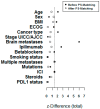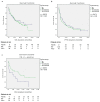Addition of Radiotherapy to Immunotherapy: Effects on Outcome of Different Subgroups Using a Propensity Score Matching
- PMID: 32867046
- PMCID: PMC7563550
- DOI: 10.3390/cancers12092429
Addition of Radiotherapy to Immunotherapy: Effects on Outcome of Different Subgroups Using a Propensity Score Matching
Abstract
Immune checkpoint inhibition (ICI) has been established as successful modality in cancer treatment. Combination concepts are used to optimize treatment outcome, but may also induce higher toxicity rates than monotherapy. Several rationales support the combination of radiotherapy (RT) with ICI as radioimmunotherapy (RIT), but it is still unknown in which clinical situation RIT would be most beneficial. Therefore, we have conducted a retrospective matched-pair analysis of 201 patients with advanced-stage cancers and formed two groups treated with programmed cell death protein 1 (PD-1) inhibitors only (PD1i) or in combination with local RT (RIT) at our center between 2013 and 2017. We collected baseline characteristics, programmed death ligand 1 (PD-L1) status, mutational status, PD-1 inhibitor and RT treatment details, and side effects according to the Common Terminology Criteria for Adverse Events (CTCAE) v.5.0. Patients received pembrolizumab (n = 93) or nivolumab (n = 108), 153 with additional RT. For overall survival (OS) and progression-free survival (PFS), there was no significant difference between both groups. After propensity score matching (PSM), we analyzed 96 patients, 67 with additional and 29 without RT. We matched for different covariates that could have a possible influence on the treatment outcome. The RIT group displayed a trend towards a longer OS until the PD1i group reached a survival plateau. PD-L1-positive patients, smokers, patients with a BMI ≤ 25, and patients without malignant melanoma showed a longer OS when treated with RIT. Our data show that some subgroups may benefit more from RIT than others. Suitable biomarkers as well as the optimal timing and dosage must be established in order to achieve the best effect on cancer treatment outcome.
Keywords: PD-1/PD-L1; combination treatment; immune checkpoint inhibition; propensity score matching; radioimmunotherapy; radiotherapy; subgroups.
Conflict of interest statement
Consultant honoraria: BMS (C.B.). The funders had no role in the design of the study; in the collection, analyses, or interpretation of data; in the writing of the manuscript; or in the decision to publish the results.
Figures






Similar articles
-
Association of Survival and Immune-Related Biomarkers With Immunotherapy in Patients With Non-Small Cell Lung Cancer: A Meta-analysis and Individual Patient-Level Analysis.JAMA Netw Open. 2019 Jul 3;2(7):e196879. doi: 10.1001/jamanetworkopen.2019.6879. JAMA Netw Open. 2019. PMID: 31290993 Free PMC article.
-
Fostering efficacy of anti-PD-1-treatment: Nivolumab plus radiotherapy in advanced non-small cell lung cancer - study protocol of the FORCE trial.BMC Cancer. 2019 Nov 8;19(1):1074. doi: 10.1186/s12885-019-6205-0. BMC Cancer. 2019. PMID: 31703637 Free PMC article. Clinical Trial.
-
Closed system RT-qPCR as a potential companion diagnostic test for immunotherapy outcome in metastatic melanoma.J Immunother Cancer. 2019 Sep 18;7(1):254. doi: 10.1186/s40425-019-0731-9. J Immunother Cancer. 2019. PMID: 31533832 Free PMC article.
-
The Next Immune-Checkpoint Inhibitors: PD-1/PD-L1 Blockade in Melanoma.Clin Ther. 2015 Apr 1;37(4):764-82. doi: 10.1016/j.clinthera.2015.02.018. Epub 2015 Mar 29. Clin Ther. 2015. PMID: 25823918 Free PMC article. Review.
-
PD-1/PD-L1 Blockade Therapy in Advanced Non-Small-Cell Lung Cancer: Current Status and Future Directions.Oncologist. 2019 Feb;24(Suppl 1):S31-S41. doi: 10.1634/theoncologist.2019-IO-S1-s05. Oncologist. 2019. PMID: 30819829 Free PMC article. Review.
Cited by
-
Updating historical normal tissue dose/volume constraints to current levels of treatment precision and accuracy.Phys Imaging Radiat Oncol. 2025 Feb 6;33:100725. doi: 10.1016/j.phro.2025.100725. eCollection 2025 Jan. Phys Imaging Radiat Oncol. 2025. PMID: 40123776 Free PMC article. No abstract available.
-
A Pilot Study of Pembrolizumab Combined With Stereotactic Ablative Radiotherapy for Patients With Advanced or Metastatic Sarcoma.Cancer Control. 2024 Jan-Dec;31:10732748241237331. doi: 10.1177/10732748241237331. Cancer Control. 2024. PMID: 38449377 Free PMC article. Clinical Trial.
-
Effect and Tolerability of Immunotherapy in Patients with NSCLC with or without Brain Metastasis.Cancers (Basel). 2022 Mar 25;14(7):1682. doi: 10.3390/cancers14071682. Cancers (Basel). 2022. PMID: 35406453 Free PMC article.
-
Oncologic Outcome and Immune Responses of Radiotherapy with Anti-PD-1 Treatment for Brain Metastases Regarding Timing and Benefiting Subgroups.Cancers (Basel). 2022 Feb 27;14(5):1240. doi: 10.3390/cancers14051240. Cancers (Basel). 2022. PMID: 35267546 Free PMC article.
References
-
- Robert C., Ribas A., Schachter J., Arance A., Grob J.J., Mortier L., Daud A., Carlino M.S., McNeil C.M., Lotem M., et al. Pembrolizumab versus ipilimumab in advanced melanoma (KEYNOTE-006): Post-hoc 5-year results from an open-label, multicentre, randomised, controlled, phase 3 study. Lancet Oncol. 2019;20:1239–1251. doi: 10.1016/S1470-2045(19)30388-2. - DOI - PubMed
-
- Leighl N.B., Hellmann M.D., Hui R., Carcereny E., Felip E., Ahn M.-J., Eder J.P., Balmanoukian A.S., Aggarwal C., Horn L., et al. Pembrolizumab in patients with advanced non-small-cell lung cancer (KEYNOTE-001): 3-year results from an open-label, phase 1 study. Lancet Respir. Med. 2019;7:347–357. doi: 10.1016/S2213-2600(18)30500-9. - DOI - PubMed
-
- Ferris R.L., Blumenschein G., Fayette J., Guigay J., Colevas A.D., Licitra L., Harringtong K.J., Kasper S., Vokes E.E., Even C., et al. Nivolumab vs investigator’s choice in recurrent or metastatic squamous cell carcinoma of the head and neck: 2-year long-term survival update of CheckMate 141 with analyses by tumor PD-L1 expression. Oral Oncol. 2018;81:45–51. doi: 10.1016/j.oraloncology.2018.04.008. - DOI - PMC - PubMed
-
- Sharma P., Callahan M.K., Bono P., Kim J.W., Spiliopoulou P., Calvo E., Pillai R.N., Ott P.A., De Braud F.G., Morse M., et al. Nivolumab monotherapy in metastatic urothelial carcinoma: Longer-term efficacy and safety results from the CheckMate 032 study. J. Clin. Oncol. 2018;36(Suppl. 6):414. doi: 10.1200/JCO.2018.36.6_suppl.414. - DOI - PubMed
-
- Hodi F.S., Chiarion-Sileni V., Gonzalez R., Grob J.J., Rutkowski P., Cowey C.L., Lao C.D., Schadendorf D., Wagstaff J., Dummer R., et al. Nivolumab plus ipilimumab or nivolumab alone versus ipilimumab alone in advanced melanoma (CheckMate 067): 4-year outcomes of a multicentre, randomised, phase 3 trial. Lancet Oncol. 2018;19:1480–1492. doi: 10.1016/S1470-2045(18)30700-9. - DOI - PubMed
LinkOut - more resources
Full Text Sources
Research Materials
Miscellaneous

